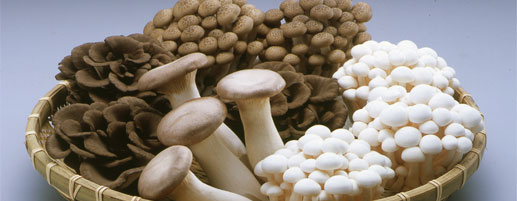
Last week’s blog targeted the growing trend of simplifying meals with an emphasis on flavor and health. Today’s blog continues with more food trends identified by The Food Channel and CNN for 2010, and how Hokto mushrooms fit right in.
Food Trends in 2010
• Back to basics economy and a return to natural ingredients
• Flavor delivery using international foods
• Food Safety
• Sustainability
• Foods with nutritional benefits
• Food with flavor (Umami)
Back to Basics Economy and a Return to Natural Ingredients Flavor Delivery Using International Foods
In today’s economical state, it’s no surprise that more people are cooking at home. What’s new is how meals have changed and the trend towards expressing individuality and cultural diversity by using more exotic foods and flavors. Immigration has contributed to America’s melting pot of flavors adding exotic foods and flavors. Hokto mushroom’s striking appearance can certainly be described as an exotic, international food contributing superb flavor to most meals. How’s that for a perfect fit in this year’s food trend?
Food Safety and Sustainability
Food safety is a big public health issue in the US and abroad. Although no one knows for sure because food poisoning often goes unreported, approximately 76 million cases of food-borne disease occur in United States each year. Bugs like e coli and Salmonella plague not only meat-containing products, but can also extend to non-meat items such as vegetables and fruit, including sprouts, tomatoes, cantaloupe and others. Last year Salmonella was found in beef, peanut butter and even refrigerated cookie dough, resulting in recalls and hospitalizations. But thanks to Hokto’s technological advances and decontamination procedures, the company is able to provide a safe supply of mushrooms all year round. Remember that unlike conventionally grown mushrooms (using dirt), these mushrooms are cultivated in pre-sterilized bottles containing an all natural substrate of rice meal, corn cob meal and soybean meal. No pesticides are used because the cultivation and growing process does not require soil. No soil means a “clean” product that can be used directly from the packaging to the saucepan for cooking.
A tour of the facility provided me with insight into the sanitation process, including a “decontamination” procedure. Employees in the production facility wore caps and masks. Much of the operation is automated, using conveyor belts in the growing rooms, cooling chambers, and in the harvesting and packing facility; therefore contamination is minimized even further, contributing to a very safe product.
Sustainable farming supports the health and well being of the company, employees and the community at large. Hokto’s 262,000 square-foot indoor farm in San Marcos is one of the most energy-efficient commercial buildings in California, receiving an Excellence in Energy Savings Merit Award from San Diego Gas and Electric for its energy-efficient equipment, such as high-efficiency rooftop chillers and variable-speed controls. In addition, the substrate that provides nutrients for the mushrooms is recycled as animal fodder and for land fertilizer.
Next week’s blog discusses the final two food trends of 2010, with an emphasis on flavorful foods with nutritional benefits. Stay tuned!

